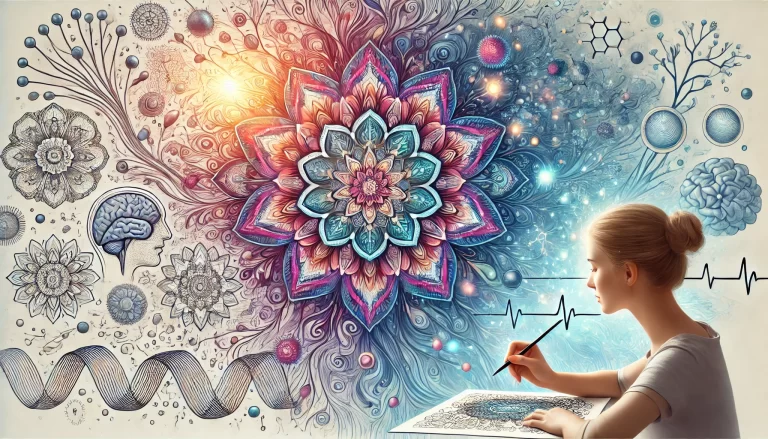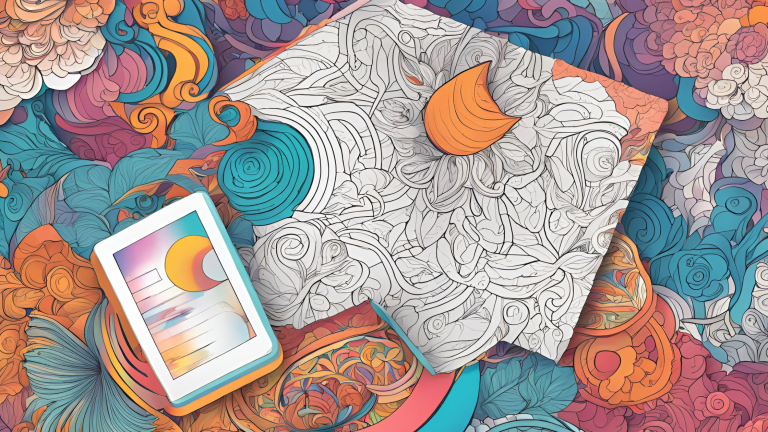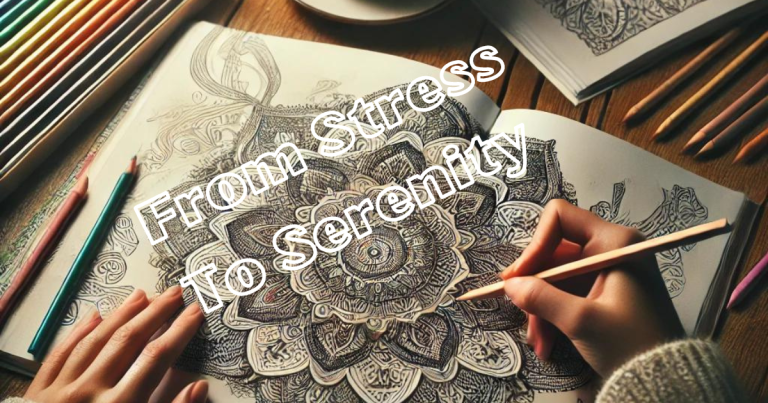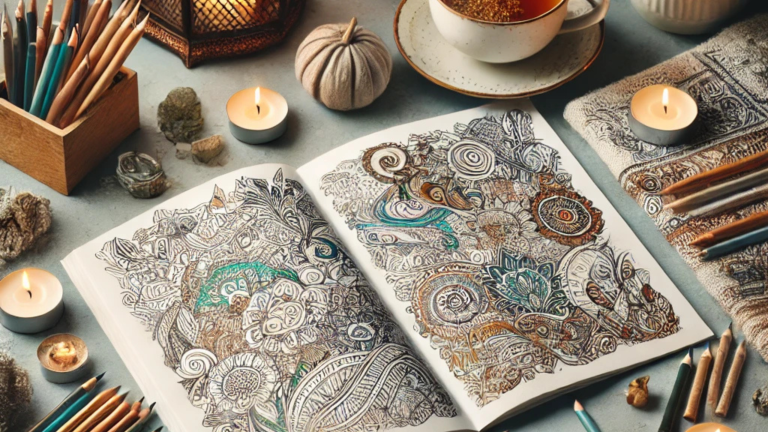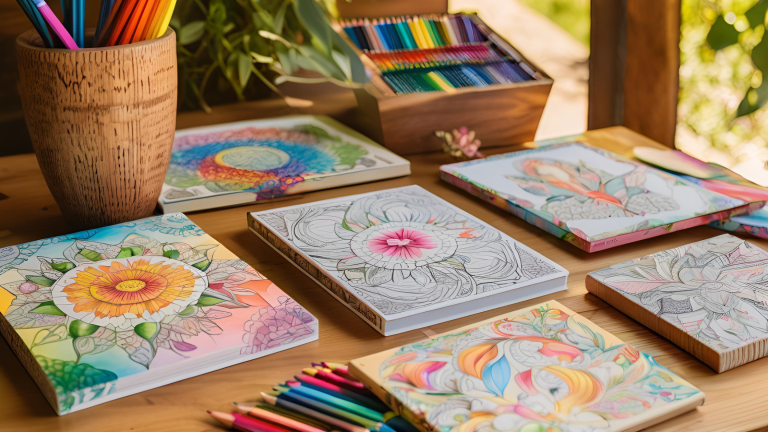10 Benefits of Mindful Coloring for Adults: Reduce Stress & Boost Creativity
In a world filled with constant noise and distractions, finding simple ways to relax and recharge has become more important than ever. Enter mindful coloring—a creative and meditative practice that’s taking the world by storm. Far from being just a pastime for kids, coloring has proven benefits for adults, offering a unique blend of stress relief, focus, and self-expression.
Whether you’re looking to escape the pressures of daily life, spark your creativity, or simply find a moment of calm amidst the chaos, mindful coloring provides an accessible and enjoyable way to improve your overall well-being. The best part? It doesn’t require any artistic skill—just a willingness to let go, immerse yourself in the process, and let the colors flow.
In this post, we’ll explore 10 powerful ways mindful coloring can transform your mental, emotional, and physical health, showing you why this simple activity has become a beloved tool for relaxation and self-care. Let’s dive in!
What is Mindful Coloring?
Mindful coloring is a form of art therapy that blends creativity with mindfulness—the practice of being fully present and engaged in the moment. Unlike casual doodling or coloring without intention, mindful coloring encourages a focused, meditative approach to the process. It involves deliberately choosing colors, paying attention to details, and immersing yourself in the rhythm of coloring to quiet the mind and relieve stress.
At its core, mindful coloring is about being present—allowing yourself to enjoy the process without judgment, worry, or distraction. It’s not about perfection or creating a masterpiece; rather, it’s about letting go, embracing creativity, and finding relaxation through the act of coloring.
How Mindful Coloring Works
- Focus on the Present: Instead of multitasking or overthinking, mindful coloring encourages you to concentrate on the here and now—each stroke, each color, and each pattern.
- Engages the Mind and Hands: The combination of visual focus and hand movements creates a calming effect, similar to meditation.
- Encourages Non-Judgmental Creativity: Unlike traditional art, where there may be expectations or pressure to “get it right,” mindful coloring is about enjoying the process without self-criticism.
- Creates a Meditative State: As you focus on filling in designs, your brain naturally slows down, reducing stress and fostering relaxation.
Mindful Coloring vs. Regular Coloring
While all coloring can be enjoyable, mindful coloring is different because of its benefits of mindful coloring for adults such as emphasizes awareness and intention. Here’s how it differs:
| Regular Coloring | Mindful Coloring |
|---|
| Coloring passively, often while distracted (e.g., watching TV) | Coloring with full attention and presence |
| Choosing colors randomly without much thought | Selecting colors based on mood, emotion, or preference |
| Focusing on completing the page quickly | Enjoying the process, without rushing |
| Might feel frustrating if mistakes are made | Accepting mistakes as part of the experience |
Why Mindful Coloring is Powerful
Some more of the benefits of mindful coloring for adults is that it combines art therapy and meditation, creating a unique practice that soothes the nervous system. Because it requires just enough concentration to keep your mind engaged—but not overwhelmed—it allows your thoughts to slow down and creates a sense of peace. This is why it’s often compared to activities like yoga, deep breathing, or journaling as a tool for mindfulness and self-care.
How to Practice Mindful Coloring
- Choose a Quiet Space: Minimize distractions and create a calming environment.
- Take Deep Breaths Before Starting: Center yourself before picking up your colors.
- Select Colors Intentionally: Pay attention to the colors you are drawn to—are they soothing, energizing, or reflective of your mood?
- Move Slowly & Enjoy the Process: Focus on each stroke rather than rushing to finish.
- Stay Present: If your mind starts to wander, gently bring your focus back to the page.
Mindful coloring is more than a simple pastime—it’s a deeply therapeutic practice that nurtures both the mind and body. By immersing yourself in the rhythmic flow of coloring, you create space for relaxation, self-expression, and mental clarity.
Whether you’re looking to unwind after a long day, boost your focus, or spark creativity, mindful coloring offers a range of benefits that can enhance your well-being in surprising ways. Let’s explore how this practice can positively impact your life.
Benefits of Mindful Coloring for Adults
1. Reduces Stress and Anxiety
Mindful coloring is a powerful tool for reducing stress and anxiety because it shifts your focus away from daily worries and places you in the present moment. The act of coloring is meditative—it requires your attention but doesn’t overwhelm your mental capacity, creating a state of calm.
One of the most well-documented benefits of mindful coloring is its ability to significantly reduce stress and anxiety. In today’s fast-paced world, where we’re constantly juggling responsibilities and dealing with information overload, stress has become a common part of daily life. Coloring offers a simple yet effective way to unplug, slow down, and refocus.
The act of coloring stimulates the brain’s relaxation response. Similar to meditation, it encourages a state of mindfulness, where your attention is focused solely on the present task—choosing colors, staying within the lines, and completing patterns. This redirection of focus helps quiet the “fight or flight” response associated with stress and promotes a sense of calm and control.
Scientific research supports this connection between coloring and stress reduction. A study published in Art Therapy: Journal of the American Art Therapy Association found that coloring mandalas and other structured designs can decrease anxiety levels. This is because the repetitive, rhythmic motion of coloring acts as a form of active meditation, allowing your brain to rest and recharge.
Why It Works:
- Distraction from Stressors: Coloring redirects your thoughts away from worries and negative emotions, grounding you in the present moment.
- Engages the Relaxation Response: By focusing on a creative task, your body reduces the production of cortisol, the hormone linked to stress.
- Promotes Mindfulness: Staying fully engaged in the act of coloring trains your brain to let go of distractions and embrace the flow of the moment.
Practical Application:
- Use coloring as part of your daily routine, even for just 10–15 minutes, to reset your mind after a stressful situation.
- Choose intricate designs like mandalas, nature patterns, or geometric shapes to maximize your focus and relaxation.
- Combine coloring with other calming practices, such as deep breathing or soft music, to enhance its stress-relieving effects.
Whether you’re unwinding after a long day or managing acute anxiety, mindful coloring offers a practical and accessible way to calm the mind, reduce tension, and cultivate inner peace.
2. Enhances Focus and Concentration
When you color mindfully, your brain enters a flow state, a psychological state of complete immersion in an activity. This state is similar to what athletes experience during peak performance or what artists feel when fully engaged in their work. It allows your mind to tune out external distractions and focus solely on the task at hand.
How Coloring Improves Focus
- Encourages Single-Tasking – Instead of multitasking, which can reduce efficiency, coloring forces you to pay attention to one thing at a time, improving your ability to concentrate.
- Activates the Prefrontal Cortex – This part of the brain is responsible for decision-making, problem-solving, and sustained attention. Coloring stimulates this area, strengthening cognitive skills over time.
- Trains Your Brain to Ignore Distractions – By focusing on intricate patterns and staying within the lines, you practice filtering out irrelevant stimuli, which can improve focus in other areas of life.
- Develops Patience and Persistence – Completing a coloring page requires careful attention to detail and a steady hand, reinforcing discipline and mental endurance.
How to Use Coloring to Improve Focus
- Set a Timer: Begin with short coloring sessions (10-15 minutes) and gradually increase the duration to train your attention span.
- Eliminate Distractions: Find a quiet space and turn off notifications to fully immerse yourself in the coloring process.
- Choose Intricate Designs: More detailed patterns require greater concentration, helping you strengthen your focus over time.
- Practice Mindful Breathing: Pair your coloring with deep, controlled breathing to further enhance mental clarity.
By incorporating mindful coloring into your routine, you’re not just creating beautiful artwork—you’re also exercising your brain’s ability to focus, filter distractions, and stay present. Over time, this practice can translate into improved concentration at work, better problem-solving skills, and an overall greater sense of mental clarity in your daily life.
3. Boosts Creativity
Mindful coloring is a powerful tool for boosting creativity because it encourages experimentation, free expression, and the ability to see things from new perspectives—all without the pressure of perfection.
How Coloring Stimulates Creativity
- Encourages Playful Experimentation – Unlike structured art forms where specific techniques or skills are required, coloring is open-ended. You can mix colors, blend shades, and try out different combinations freely, allowing your imagination to run wild.
- Activates the Right Hemisphere of the Brain – The right side of the brain is responsible for creativity, intuition, and artistic thinking. Engaging in mindful coloring exercises this part of the brain, helping you think more creatively in other areas of life.
- Breaks Creative Blocks – When you feel stuck creatively, switching to a low-pressure activity like coloring can help reset your mind. The repetitive, meditative nature of coloring allows your subconscious to work through ideas while you focus on something simple.
- Strengthens Visual Thinking – Choosing colors, patterns, and compositions helps improve spatial awareness and the ability to visualize concepts, which is useful for artists, designers, and problem-solvers alike.
- Provides a Judgment-Free Creative Space – Many adults hesitate to engage in creative activities because they fear making mistakes. Coloring removes this pressure—there’s no “right” or “wrong” way to color, making it an ideal way to explore creativity without self-doubt.
Ways to Use Coloring to Enhance Creativity
- Try Unusual Color Combinations – Challenge yourself to break away from traditional color schemes. For example, color a forest with pink trees and a purple sky to stretch your imagination.
- Use Different Coloring Tools – Experiment with colored pencils, markers, gel pens, and watercolors to explore different textures and techniques.
- Color Outside the Lines – Instead of staying within the boundaries, let your creativity flow by adding your own doodles, patterns, or blending colors in unique ways.
- Listen to Music While Coloring – Certain types of music, like instrumental or nature sounds, can enhance the creative experience and make it even more immersive.
By making mindful coloring a part of your routine, you give yourself permission to play, explore, and embrace creativity in all areas of life.
4. Promotes Relaxation and Better Sleep
Mindful coloring offers a gentle, screen-free activity that helps calm the mind and body, making it an excellent part of a bedtime routine.
How Coloring Promotes Relaxation
- Reduces Overthinking and Mental Clutter – Many people struggle with a “busy brain” at night, where thoughts about work, responsibilities, or worries keep them from fully unwinding. Coloring shifts your focus from stressful thoughts to a simple, repetitive task, helping the mind naturally slow down.
- Engages the Parasympathetic Nervous System – Coloring activates the part of the nervous system responsible for rest and relaxation. This reduces the production of stress hormones like cortisol, making it easier to transition into a state of calm.
- Encourages Deep Breathing – The rhythmic and repetitive motions of coloring can naturally encourage slower, deeper breathing, which signals the body that it’s time to relax.
- Provides a Screen-Free Alternative Before Bed – Exposure to blue light from screens (phones, tablets, and TVs) before bedtime disrupts melatonin production, making it harder to fall asleep. Coloring offers a relaxing, screen-free alternative that supports the body’s natural sleep cycle.
How to Use Coloring to Improve Sleep
- Create a Pre-Bedtime Routine – Set aside 15–30 minutes before bed to color in a quiet, dimly lit space.
- Choose Calming Color Palettes – Soft blues, purples, and pastels can have a soothing effect on the mind. Avoid overly bright or high-contrast colors right before sleep.
- Pair Coloring with Relaxing Elements – Play soft music, nature sounds, or guided meditations while coloring to enhance relaxation. You can also light a lavender-scented candle to engage your sense of smell.
- Avoid Stimulating Content Before Coloring – Instead of scrolling social media or watching intense TV shows, transition to coloring at least 30 minutes before bed to let your mind fully relax.
- Breathe Deeply While Coloring – Take slow, deep breaths as you color to activate the body’s relaxation response and signal that it’s time to wind down.
Whether you struggle with falling asleep, staying asleep, or simply want to end your day on a calming note, mindful coloring is a simple and effective way to unwind. By making it part of your nighttime routine, you can promote relaxation, reduce stress, and improve sleep quality—one color at a time.
5. Improves Emotional Well-Being
Mindful coloring serves as a powerful tool for emotional well-being by offering a safe and creative outlet for self-expression. Many adults experience stress, frustration, or emotional tension throughout the day, and without a healthy way to process these feelings, they can build up over time.
Coloring provides a nonverbal way to express emotions through colors and patterns, helping individuals process their thoughts and feelings without needing to put them into words. Whether it’s selecting bright, uplifting colors to boost mood or using soothing tones to calm an anxious mind, the act of coloring allows people to engage with their emotions in a gentle and therapeutic way.
Additionally, coloring promotes the release of dopamine, a neurotransmitter associated with pleasure, motivation, and emotional resilience. This natural mood booster can help combat stress, anxiety, and even symptoms of depression by creating a sense of accomplishment and satisfaction.
Completing a coloring page—even a small section—provides a feeling of achievement, reinforcing positive emotions and a sense of control over one’s environment. This is particularly beneficial for individuals who struggle with perfectionism or self-doubt, as coloring is a low-pressure activity where there are no mistakes, just creativity and exploration.
6. Develops Motor Skills
Mindful coloring is more than just a relaxing activity—it also helps strengthen fine motor skills, which are essential for everyday tasks such as writing, typing, and even buttoning a shirt.
The intricate movements involved in coloring—gripping a pencil, shading within lines, and adding fine details—engage the small muscles in the hands and fingers, improving dexterity and coordination over time. This can be particularly beneficial for adults looking to maintain or enhance motor function, especially those recovering from injuries, dealing with arthritis, or simply seeking to keep their hands agile as they age.
Beyond physical benefits, coloring also helps with hand-eye coordination and spatial awareness. As individuals choose colors, adjust their grip, and carefully fill in designs, they train their brains to translate visual information into precise movements.
This skill carries over into daily activities, making tasks like handwriting, painting, and using digital devices easier and more fluid. Over time, engaging in coloring regularly can act as a gentle form of occupational therapy, helping improve both motor control and cognitive engagement in a fun and stress-free way.
7. Provides a Digital Detox
In today’s hyperconnected world, we spend countless hours in front of screens—whether for work, entertainment, or social interaction. While technology has many benefits, excessive screen time can lead to mental fatigue, eye strain, and increased stress levels.
Mindful coloring provides a much-needed digital detox, allowing individuals to step away from their devices and engage in a hands-on, immersive activity that fosters relaxation and presence. Unlike scrolling through social media, which often leads to overstimulation and comparison-driven anxiety, coloring encourages a slower, more intentional pace, helping the mind shift into a state of calm and clarity.
Engaging in a non-digital activity like coloring also reduces blue light exposure, which is known to disrupt melatonin production and negatively impact sleep quality. Many people turn to their phones or tablets for relaxation, but this can actually keep the brain in a state of alertness, making it harder to wind down. Coloring offers a healthy alternative to screen-based entertainment, giving the brain a break from constant notifications and information overload.
By incorporating mindful coloring into daily routines—whether as part of a morning mindfulness practice or a pre-bedtime wind-down—adults can experience the benefits of true mental relaxation and a greater sense of balance in their digital lives.
8. Encourages Self-Expression
Mindful coloring offers a unique and accessible way for individuals to express themselves without the need for words. In a world where adults often feel pressured to conform to expectations or suppress emotions, coloring provides a safe, judgment-free space to explore feelings, ideas, and creativity.
Each color choice, shading technique, and design interpretation reflects an individual’s mood, personality, and subconscious thoughts. Unlike structured forms of art, where there may be specific guidelines or rules to follow, coloring allows for complete creative freedom—there is no right or wrong way to fill a page. This sense of autonomy fosters self-discovery and emotional release, making coloring an incredibly therapeutic tool.
For those who struggle with verbal communication or find it difficult to express emotions openly, coloring can serve as a nonverbal outlet for emotional processing. Different colors can evoke different emotions—bright and bold hues might reflect excitement or joy, while softer, muted tones may indicate a need for calmness or introspection.
Some individuals may gravitate toward certain color palettes based on their current emotional state, allowing them to externalize feelings in a way that feels natural and unforced. Over time, recognizing patterns in color choices and artistic expression can even serve as a form of self-reflection, helping individuals gain deeper insight into their inner world.
Additionally, mindful coloring can empower individuals to break free from creative self-doubt. Many adults hesitate to engage in artistic activities because they fear not being “good enough” or making mistakes. Coloring removes this pressure, encouraging a pure, joyful engagement with creativity that doesn’t require any special skills or training.
Whether it’s experimenting with abstract color schemes, blending unexpected shades, or adding personal touches to a design, mindful coloring fosters a sense of individuality and creative confidence. As a result, individuals often carry this renewed sense of self-expression into other aspects of life, from problem-solving at work to embracing new creative hobbies.
9. Builds a Sense of Accomplishment
Mindful coloring provides a tangible sense of accomplishment, as each completed section of a design or full coloring page serves as a visual representation of progress. Unlike many aspects of daily life that come with strict deadlines or performance expectations, coloring allows individuals to complete something at their own pace, without pressure or judgment. This simple act of finishing a page can provide a much-needed confidence boost, reinforcing the idea that even small efforts can lead to beautiful and meaningful outcomes.
Beyond just finishing a piece, the process of seeing improvement over time is also deeply fulfilling. As individuals engage in mindful coloring regularly, they may notice an evolution in their skills—better color blending, improved shading techniques, or greater attention to detail. This sense of progress fosters self-motivation and personal growth, helping individuals recognize their ability to improve through practice and dedication. This same mindset can be applied to larger life goals, where breaking tasks into smaller, manageable steps makes them feel less overwhelming and more achievable.
Furthermore, coloring encourages patience and persistence, as intricate designs often require extended focus and careful execution. Completing a complex pattern or working through a detailed illustration builds discipline and resilience, reinforcing the value of sticking with a task even when it requires time and effort. This subtle lesson can translate to other areas of life, such as maintaining consistency in fitness goals, work projects, or personal development. By incorporating mindful coloring into their routine, individuals can experience the satisfaction of creating something unique and meaningful, helping to boost their overall self-esteem and sense of achievement.
10. Fosters Mindfulness and Presence
Mindful coloring serves as a powerful tool to bring you back to the here and now, encouraging a state of mindfulness—where your focus is solely on the present task, free from worries about the past or anxieties about the future. By immersing yourself in the rhythmic, repetitive motion of coloring, you engage in a form of active meditation, allowing your mind to quiet as you concentrate on the simple act of selecting colors and filling in shapes.
The process of coloring naturally slows down your thoughts, creating a sense of calm and clarity. Unlike passive relaxation techniques, such as watching TV, mindful coloring requires gentle engagement, helping to train your brain to remain focused while also reducing mental clutter. Studies on mindfulness have shown that engaging in structured, low-pressure activities like coloring can enhance overall cognitive function, emotional regulation, and stress resilience. Over time, regularly practicing mindful coloring can help develop a habit of being more present in everyday life, improving concentration, patience, and emotional awareness in other activities, such as work, relationships, and self-care.
Additionally, coloring encourages a non-judgmental mindset, which is a fundamental aspect of mindfulness. Rather than worrying about whether your work is “perfect,” mindful coloring encourages you to embrace the process rather than the outcome. This shift in perspective can help reduce self-criticism, perfectionism, and negative thought patterns, reinforcing the idea that engaging in a task with full presence is valuable, regardless of the final result. Over time, this practice of letting go and simply enjoying the moment can extend beyond coloring, helping individuals cultivate greater mindfulness in other aspects of life, such as eating, walking, or even engaging in conversations with loved ones.
Best-Selling Mindfulness Coloring Books to Check Out
If you’re looking to begin or deepen your mindful coloring journey, here are some highly-rated and best-selling coloring books on Amazon designed specifically for relaxation and mindfulness:
- “The Mindfulness Coloring Book: Anti-Stress Art Therapy for Busy People“ – A beautifully illustrated book with intricate patterns and calming designs meant to reduce stress and enhance focus.
- “Stress Relieving Patterns: An Adult Coloring Book“ – Featuring soothing, detailed mandalas and nature-inspired patterns, this book is perfect for relaxation and stress relief.
- “Secret Garden: An Inky Treasure Hunt and Coloring Book” by Johanna Basford – One of the most popular mindfulness coloring books, offering whimsical, intricate designs that encourage creativity and immersion.
- “Calm the F*ck Down: An Irreverent Adult Coloring Book“ – A humorous and stress-relieving option that blends relaxation with fun, perfect for those who enjoy lighthearted self-care.
- “Mandala Coloring Book for Adults“ – A collection of detailed mandalas designed to promote relaxation, focus, and meditation, making it ideal for mindful coloring sessions.
The Transformative Power of Mindful Coloring
Mindful coloring is more than just an enjoyable pastime—it is a therapeutic practice that nurtures mental clarity, emotional balance, and overall well-being. In a world that often feels overwhelming, the simple act of coloring provides a much-needed pause, allowing us to slow down, refocus, and reconnect with the present moment. By engaging in this mindful activity, individuals can experience stress relief, improved focus, enhanced creativity, and emotional expression without the pressures of perfection or performance. Whether used as a form of relaxation, self-reflection, or a creative escape, coloring fosters a sense of calm and joy, making it a valuable tool for both mental and emotional wellness.
Beyond its psychological benefits, coloring also plays a role in cognitive and physical development, helping to strengthen fine motor skills, coordination, and concentration. It serves as a gentle digital detox, offering a break from screen time and encouraging a more mindful, tech-free experience. The sense of accomplishment that comes with completing a design reinforces self-confidence and patience, proving that even small, creative endeavors can bring a deep sense of fulfillment. Whether you color for relaxation, inspiration, or personal growth, this simple yet effective practice can become a meaningful addition to your self-care routine, helping you cultivate a greater sense of peace, focus, and creative freedom in your daily life.

